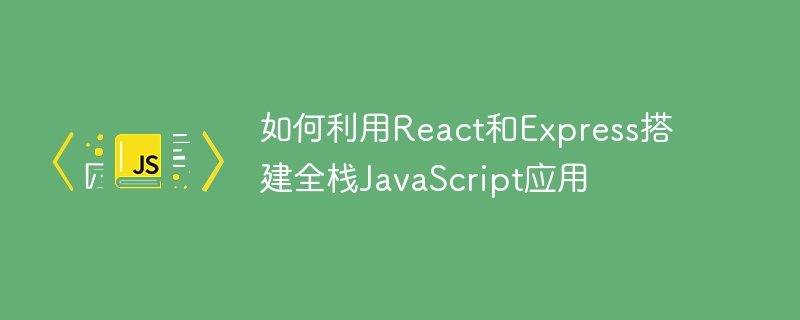

How to use React and Express to build a full-stack JavaScript application
Introduction:
React and Express are currently very popular JavaScript frameworks, which are used to build front-ends respectively and backend applications. This article will introduce how to use React and Express to build a full-stack JavaScript application. We will explain step by step how to build a simple TodoList application and provide specific code examples.
1. Preparation
Before we start, we need to prepare some necessary tools and environment:
Node.js and npm: Make sure Node is installed .js and npm (the package manager for Node.js), you can check whether they have been installed successfully through the command line, as follows:
node -v npm -v
2. Back-end construction
Initialize the project: Open the command line in the project folder and execute the following command to initialize a new Node.js project :
npm init -y
This will create a default package.json file to record project-related information and dependent packages.
Install Express and other dependencies: Execute the following commands in the command line to install Express and other required dependencies:
npm install express body-parser cors --save
Here we installed Express and body-parser and cors, used to handle HTTP requests and cross-domain requests.
server.js. Open server.js and add the following content: const express = require('express');
const bodyParser = require('body-parser');
const cors = require('cors');
const app = express();
app.use(bodyParser.urlencoded({ extended: false }));
app.use(bodyParser.json());
app.use(cors());
const PORT = process.env.PORT || 5000;
app.listen(PORT, () => {
console.log(`Server is running on port ${PORT}`);
});This code first introduces the required dependency packages, then creates an Express instance and sets up some middleware. Finally, we listen on the specified port (default is 5000).
server.js, add the following content below the existing code: let todos = [];
app.get('/api/todos', (req, res) => {
res.json(todos);
});
app.post('/api/todos', (req, res) => {
const { todo } = req.body;
todos.push(todo);
res.json(todos);
});This code definition There are two routes: one for getting all todo items, and one for adding new todo items. We use a simple array todos to store all todo items.
Start the server: Execute the following command in the command line to start the Express server:
node server.js
If everything is OK, you will see in the command line Server is running on port XXXX prompt indicates that the server has been started successfully.
3. Front-end construction
Create a React application: Return to the project folder and execute the following command on the command line to create a new React application:
npx create-react-app client
This will create a new folder named client under the project folder to store our React front-end application code.
client/src/App.js file you just created and replace the code in it with the following content: import React, { useState, useEffect } from "react";
function App() {
const [todos, setTodos] = useState([]);
const [newTodo, setNewTodo] = useState("");
useEffect(() => {
fetch("/api/todos")
.then(res => res.json())
.then(data => setTodos(data));
}, []);
const handleInputChange = e => {
setNewTodo(e.target.value);
};
const handleSubmit = e => {
e.preventDefault();
const todo = { todo: newTodo };
fetch("/api/todos", {
method: "POST",
headers: { "Content-Type": "application/json" },
body: JSON.stringify(todo)
})
.then(res => res.json())
.then(data => setTodos(data))
.catch(err => console.log(err));
setNewTodo("");
};
return (
<div>
<h1>Todo List</h1>
<form onSubmit={handleSubmit}>
<input value={newTodo} onChange={handleInputChange} />
<button type="submit">Add Todo</button>
</form>
<ul>
{todos.map((todo, index) => (
<li key={index}>{todo}</li>
))}
</ul>
</div>
);
}
export default App;This code defines a React function componentApp, which is used to display the todo list. The component uses two React Hooks, useState and useEffect, to handle the state and side effects of the component. We use the fetch function to send HTTP requests and obtain data.
Start the React application: Open the command line under the project folder, enter the client folder, and execute the following command to start the React development server:
npm start
If everything goes well, you will see a simple TodoList application in the browser, and you can add new todo items.
Conclusion:
Through the steps in this article, we successfully built a simple full-stack JavaScript application using React and Express together. You can further extend the functionality of the application according to your needs, such as adding editing and deletion functions, or using a database to store data. Full-stack development allows us to give full play to the advantages of front-end and back-end technologies at the same time and improve development efficiency. I hope this article will be helpful to you.
The above is the detailed content of How to build a full-stack JavaScript application using React and Express. For more information, please follow other related articles on the PHP Chinese website!
 The difference between bond0 and bond1
The difference between bond0 and bond1
 The difference between computer hibernation and sleep
The difference between computer hibernation and sleep
 mysql default transaction isolation level
mysql default transaction isolation level
 sort function python usage
sort function python usage
 Introduction to the meaning of javascript
Introduction to the meaning of javascript
 The m2m concept in the Internet of Things
The m2m concept in the Internet of Things
 y460 graphics card switching
y460 graphics card switching
 What are the virtual currency trading platforms?
What are the virtual currency trading platforms?




